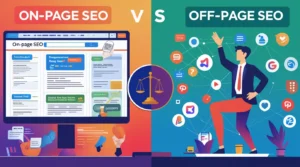How Page Speed Affects SEO & How to Optimize for Faster Rankings
Page speed is one of the most crucial factors that determine the success of a website. It influences user experience, conversion rates, and, most importantly, search engine rankings. With search engines like Google prioritizing fast-loading websites, page speed has evolved from being a mere technical metric to an essential SEO ranking factor.
Jump to
ToggleA slow-loading website frustrates users, increases bounce rates, and negatively impacts overall engagement. On the other hand, a website that loads quickly creates a seamless user experience, encouraging visitors to stay longer and interact with the content.
In this article, we’ll explore why page speed is important, how it affects SEO rankings, and practical ways to optimize it for better performance.
What is Page Speed?
Page speed refers to how fast the content on a website loads when a user visits a page. It is often measured by three key factors:
- First Contentful Paint (FCP) – The time it takes for the first visible element of a webpage to appear.
- Largest Contentful Paint (LCP) – The time it takes for the largest visible element (e.g., an image or heading) to load.
- Time to Interactive (TTI) – The time it takes for a webpage to become fully interactive and functional.
Google’s Core Web Vitals framework focuses heavily on these metrics, making them essential for improving SEO rankings and user experience.
Why Page Speed Matters for SEO
1. Google Uses Page Speed as a Ranking Factor
Google has explicitly stated that page speed is a ranking factor. The search engine rolled out its first speed-related update in 2010, focusing on desktop searches. In 2018, the Speed Update extended this ranking factor to mobile searches, making page speed even more critical in an era where mobile users dominate internet traffic.
Example:
A study by Google found that as page load time increases from 1 second to 3 seconds, the probability of a user bouncing increases by 32%. If the page takes 5 seconds, the likelihood of bounce jumps to 90%. This means slower websites are losing visitors before they even get a chance to explore the content.
2. Improved User Experience (UX) Leads to Better Rankings
Google aims to provide users with the best possible experience. A slow-loading website frustrates users, leading to higher bounce rates and lower engagement. Google considers these behavioral signals when ranking websites.
Example:
Imagine you’re searching for a recipe, and you visit a website that takes over five seconds to load. Frustrated, you go back to Google and click on a different result. This action, known as pogo-sticking, sends a signal to Google that the first site didn’t satisfy the user’s intent, potentially hurting its rankings.
3. Page Speed Affects Crawlability
Search engines use bots to crawl and index web pages. If a website loads slowly, search engine crawlers may struggle to index all the pages efficiently, which can negatively impact how content appears in search results.
Google allocates a “crawl budget” to each website, determining how many pages it will crawl within a given timeframe. A slow website consumes this budget inefficiently, leading to some pages not being indexed at all.
4. Better Conversion Rates and Revenue
For businesses, page speed directly influences conversion rates and revenue. Studies have shown that faster websites generate higher sales and customer engagement.
Case Study:
Walmart saw a 2% increase in conversion rates for every 1-second improvement in page load time. Similarly, Amazon found that a 100-millisecond delay in load time could reduce sales by 1%. These statistics highlight how crucial page speed is for online businesses.
Common Causes of Slow Page Speed
1. Large and Unoptimized Images
High-resolution images consume significant bandwidth, slowing down web pages. Using oversized images without proper compression negatively impacts load times.
2. Excessive HTTP Requests
Every time a browser loads a page, it requests multiple files (CSS, JavaScript, images, etc.). The more requests a website makes, the longer it takes to load.
3. Unoptimized JavaScript and CSS
Bulky JavaScript and CSS files delay rendering times, making the page load slower. Minifying these files can significantly enhance speed.
4. Slow Server Response Time
If a website’s server takes too long to respond, page load speed suffers. A slow hosting provider, lack of caching, or excessive website traffic can all contribute to slow server responses.
5. Too Many Redirects
Excessive redirects (301s, 302s) create unnecessary loading delays. Each redirect adds an extra HTTP request-response cycle, reducing performance.
6. No Caching Strategy
Caching stores website data temporarily so that repeat visitors experience faster load times. Without proper caching, browsers reload everything from scratch, slowing down performance.
How to Improve Page Speed for Better SEO
1. Optimize Images
- Compress images using tools like TinyPNG or ImageOptim.
- Use next-gen formats like WebP instead of PNG and JPEG.
- Implement lazy loading so images only load when they enter the viewport.
2. Reduce HTTP Requests
- Minimize the number of CSS, JavaScript, and image files.
- Combine multiple files into one where possible.
- Use asynchronous loading for non-essential scripts.
3. Minify CSS, JavaScript, and HTML
- Remove unnecessary whitespace and comments in code.
- Use tools like UglifyJS (for JavaScript) and CSSNano (for CSS) to minify files.
4. Leverage Browser Caching
- Enable caching to store static assets (images, CSS, JavaScript) in the user’s browser.
- Use a proper cache expiration strategy to prevent unnecessary reloading.
5. Improve Server Response Time
- Choose a reliable hosting provider with good performance.
- Use a Content Delivery Network (CDN) to serve content faster across different locations.
- Reduce database queries and optimize backend processes.
6. Enable Gzip Compression
Gzip compression reduces file sizes, making it faster to transfer data between the server and browser. This results in improved load times.
7. Use a Content Delivery Network (CDN)
A CDN distributes website content across multiple servers worldwide, ensuring users access the nearest server for faster loading times.
8. Eliminate Render-Blocking Resources
Render-blocking JavaScript and CSS delay page rendering. To fix this:
- Use async or defer attributes for JavaScript files.
- Inline critical CSS and load non-critical styles asynchronously.
9. Reduce Redirects
Audit and eliminate unnecessary redirects to improve speed. Each redirect introduces an additional round-trip request, slowing page loads.
10. Monitor and Test Page Speed Regularly
Use tools like:
- Google PageSpeed Insights – Provides recommendations for improving speed.
- GTmetrix – Analyzes performance and provides a detailed breakdown.
- Lighthouse – Google’s open-source tool for auditing performance and accessibility.
Conclusion
Page speed is no longer just a technical concern-it’s a crucial factor influencing SEO rankings, user experience, and business success. A slow website not only frustrates visitors but also reduces organic visibility, engagement, and conversions.
By optimizing images, minifying files, leveraging caching, and choosing the right hosting, businesses can dramatically improve their website performance.
In an era where speed equals success, ensuring your website loads in under 3 seconds is not just an advantage-it’s a necessity. If you’re serious about SEO and user satisfaction, improving page speed should be at the top of your priority list.
Now that you understand the impact of page speed, it’s time to take action. Run a speed test, identify weak points, and start optimizing today. Your website’s success depends on it! 🚀







